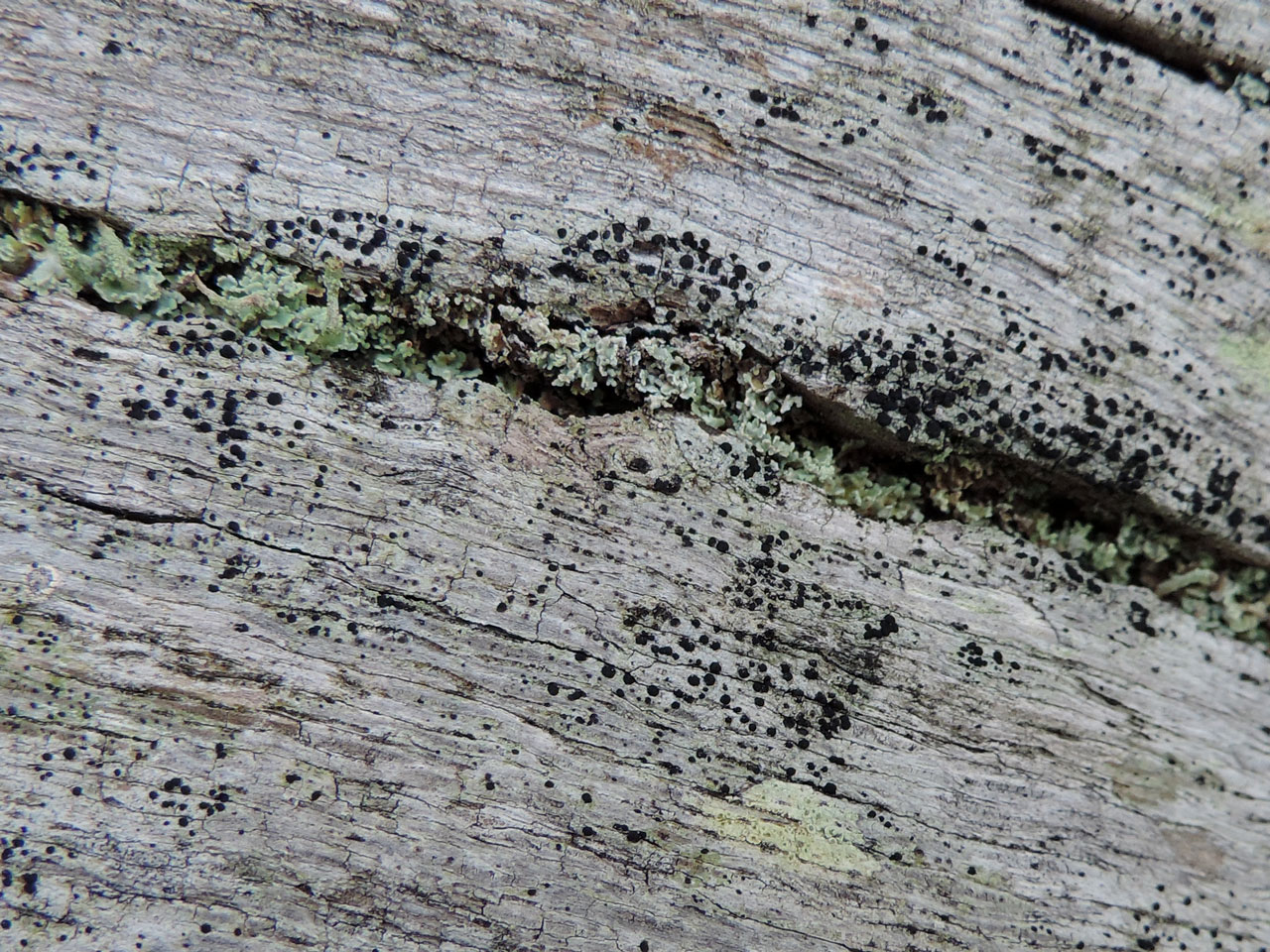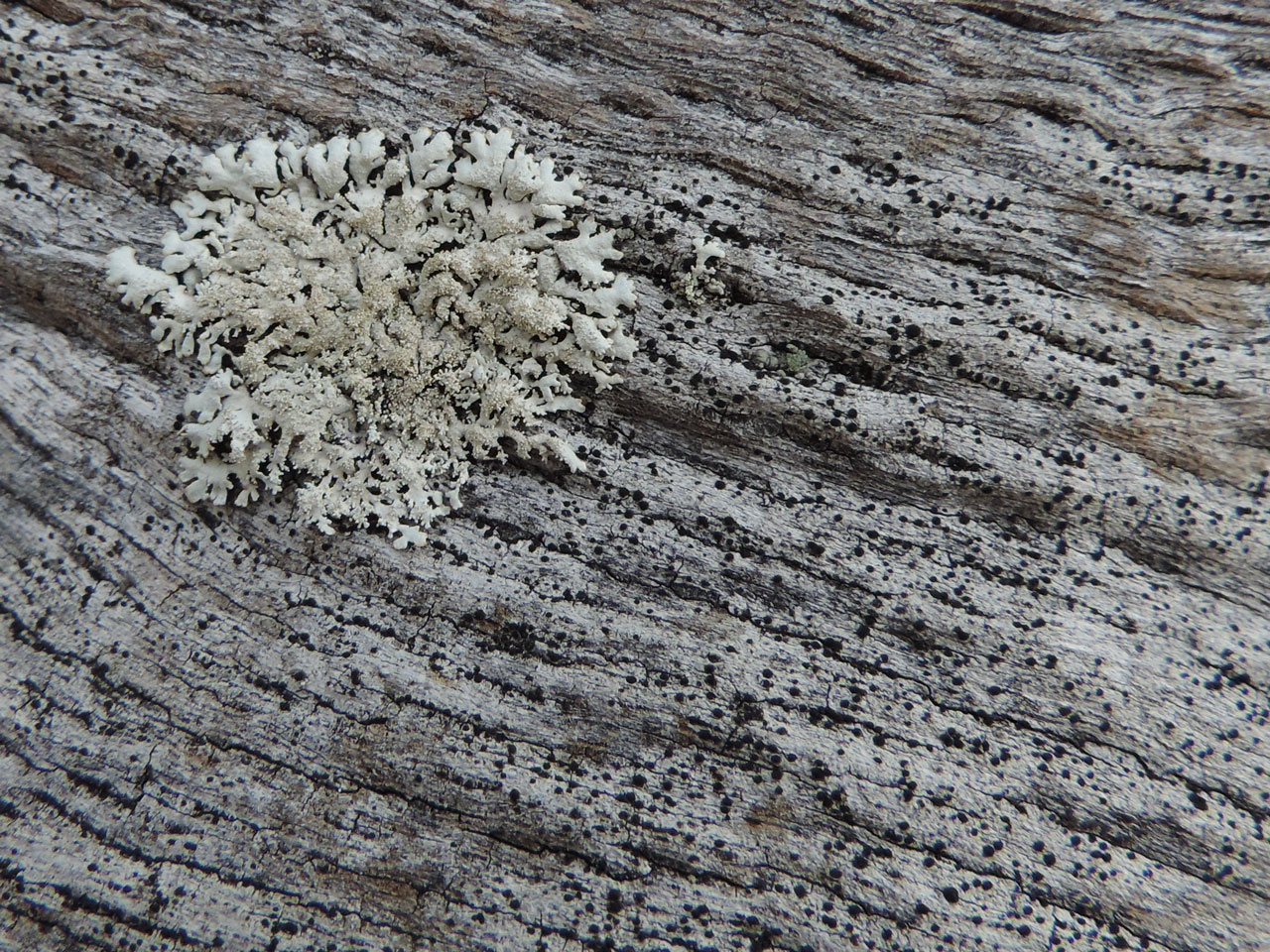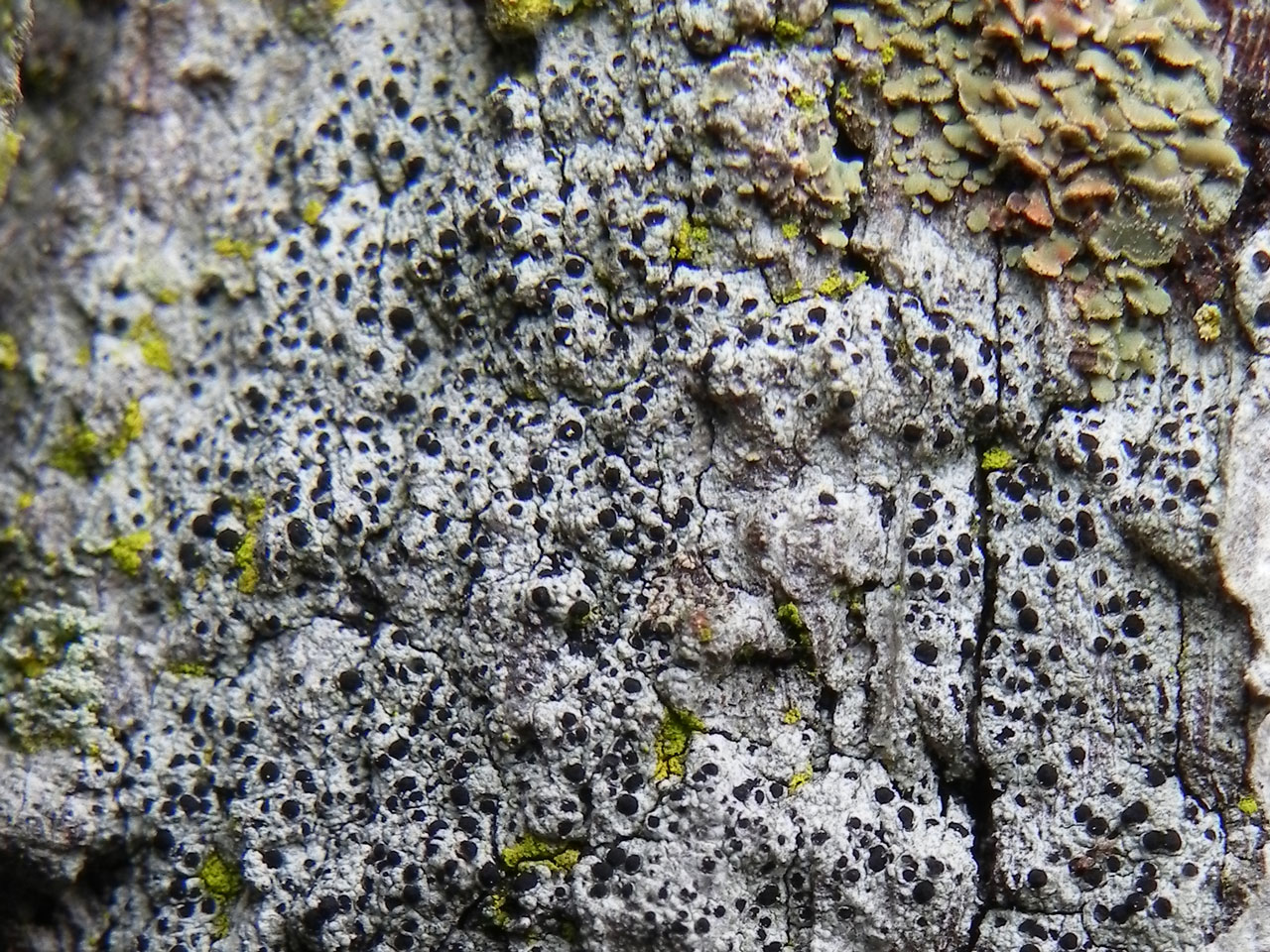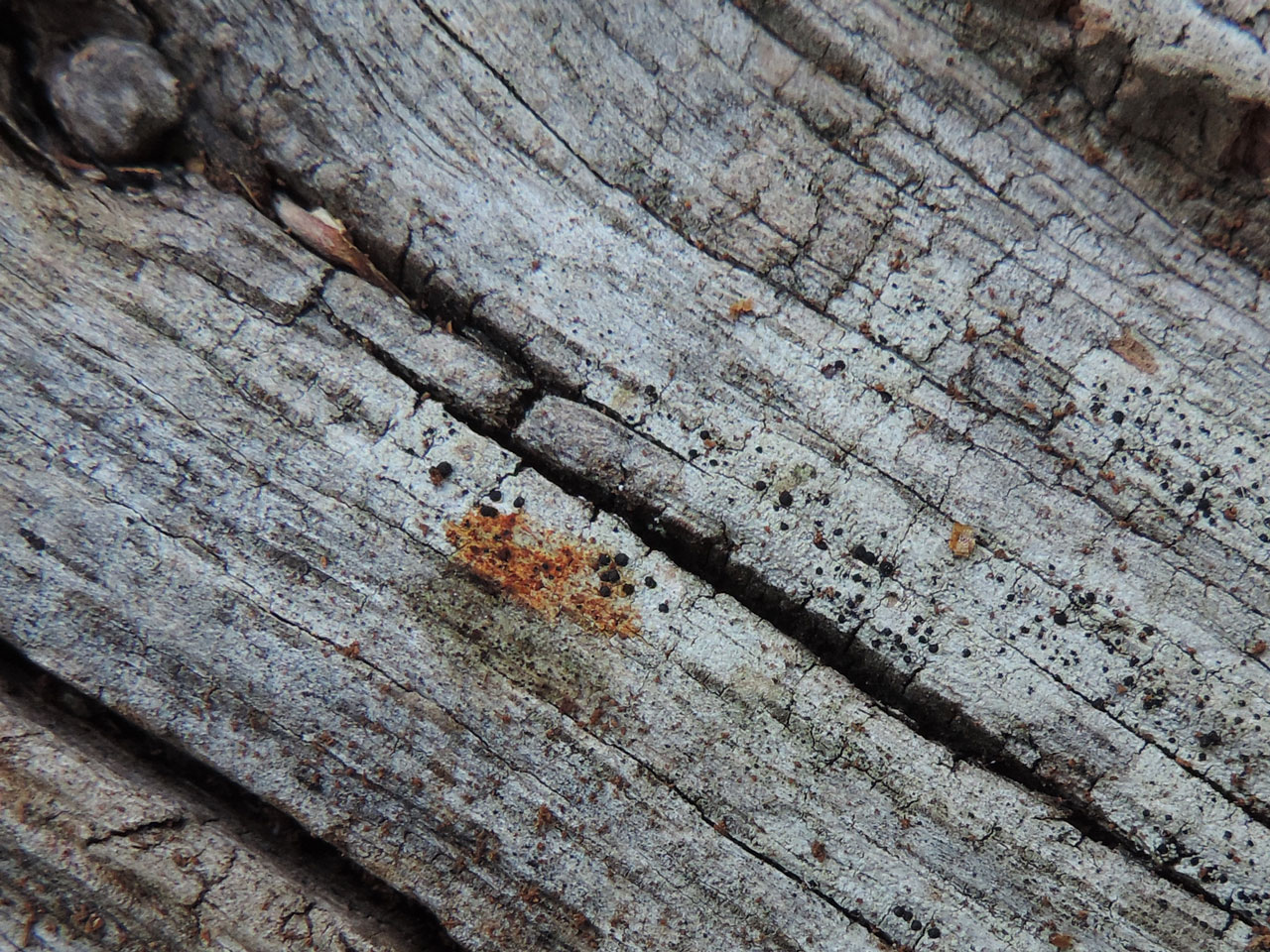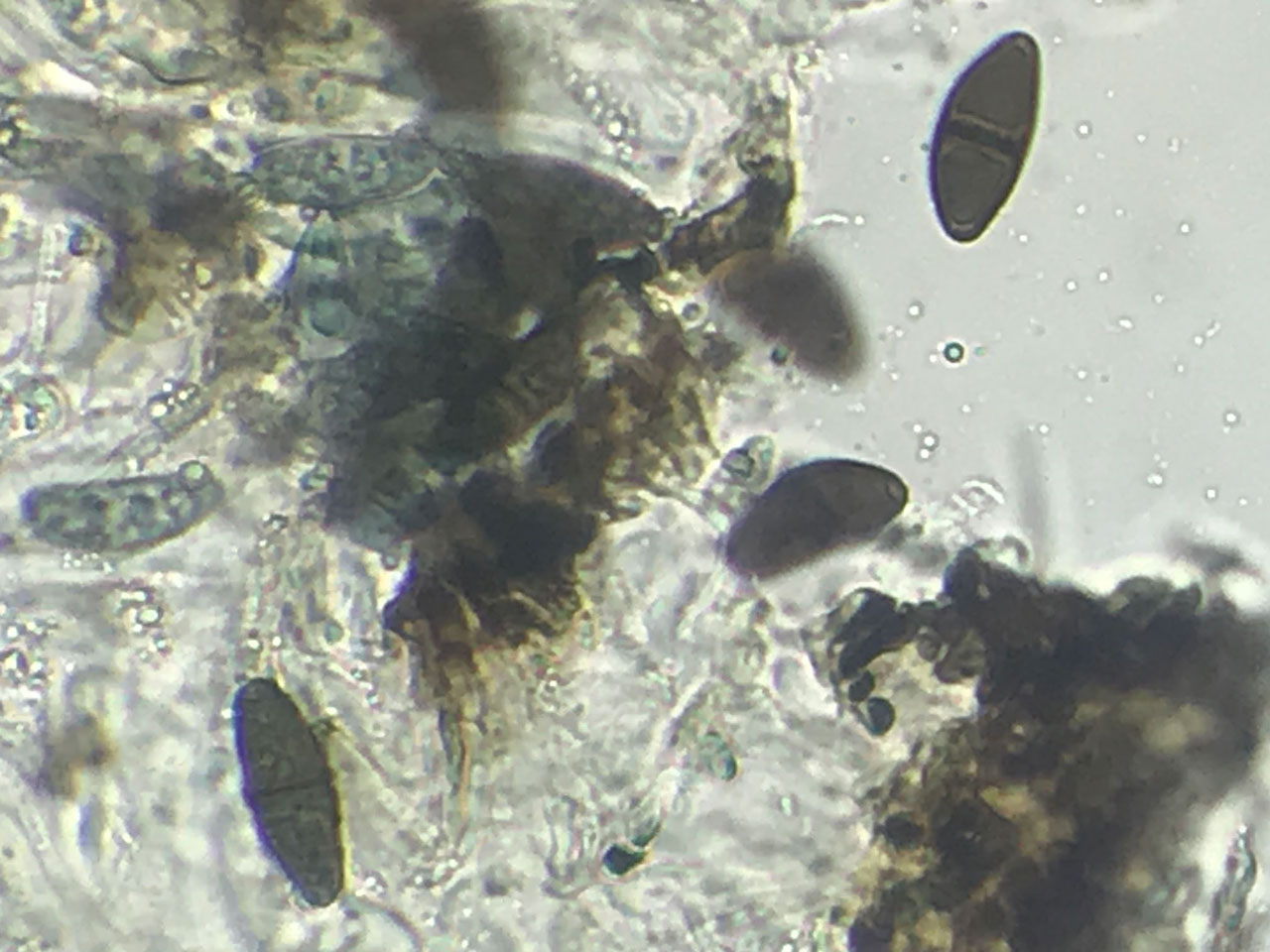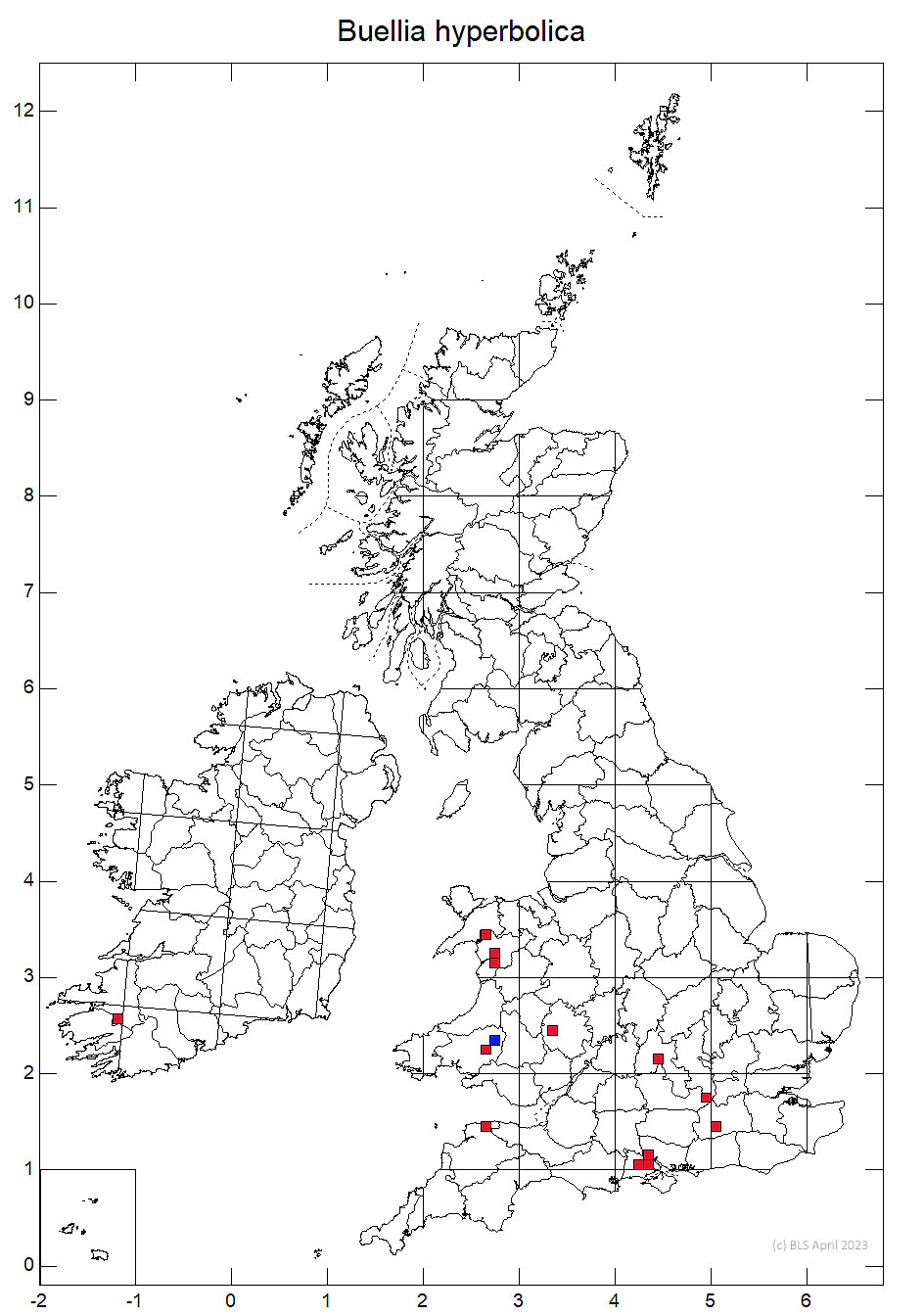Buellia hyperbolica
An internationally rare southern oceanic – humid Mediterranean lichen found on acid bark on veteran trees and hard weathered lignum. Confined to pasture woodland and parkland in the south and south west. Distinctive in the combination of white warty granular thallus, the black apothecia and the Pd+ orange- red spot test.
Thallus of white, pale grey to yellow-green granules, ± continuous, usually covering a wide area. Apothecia lecideine, rapidly becoming biatorine, 0.2–0.3 (–0.4) mm diam., adnate, abundant and confluent; disc flat at first, soon hemispherical; thalline margin very thin, and even when juvenile becoming almost totally excluded; true exciple poorly developed, to 20 μm thick; hymenium without oil droplets, 70–90 (–100) μm high; hypothecium inspersed with abundant oil droplets, 100–120 μm tall; apical cells of the paraphyses markedly swollen, to (3.5–) 4–5 μm diam., pigmented dark brown. Ascospores (19–) 21–24 (–29) × (7.5–) 8–9.5 (–11) μm, when young with the inner wall thickened at the septum; when mature walls uniformly thin; apices pointed, often slightly curved, roughly ornamented. Pycnidia unknown. Thallus C–, K+ yellow-brown, Pd+ orange- red, UV– (± atranorin, fumarprotocetraric, protocetraric, confumarprotocetraric and ± convirensic acids).
The combination of the strongly developed granular white thallus with black apothecia on acid bark or lignum and the Pd + orange-red reaction is highly distinctive. Amandinea punctata can occur in the same sites and has similar apothecia but has a very different thin greenish thallus, which is Pd –. Microscopically the species is distinguished by the hymenium lacking numerous oil droplets and the large size of the spores (<19μm long).
On acid bark and lignum, mainly on old Oak but also Sweet Chestnut, Birch, Yew and ornamental conifers, in parks and pasture woodlands. Buellia hyperbolica has only been found in sites with frequent veteran trees and typically frequent large diameter dead, both standing dead and fallen, trees. These can be either parklands or the more open parts of old growth pasture woodlands. It is quite light demanding and is absent from the more shaded parts of woodlands. It occurs in two distinct habitats bark and lignum. In both the substrate is strongly acidic and moderately dry. On bark it grows in the drier parts of flushed acid bark communities but avoids both dry bark communities and wetter flushed bark. Similarly on lignum it avoids both Cladonia dominated damp wood and very dry pinhead dominated lignum.
As well as fallen dead wood and lignum and bark low down on the trunks of standing trees a third niche for Buellia hyperbolica has been observed in the New Forest and Windsor Forest. This is on the lignum of dead branches high up on stag headed veteran Oaks. The lichen is only apparent in this niche when the branches or trees fall down and stag headed Oaks may be quite a significant unobserved habitat.
Sanderson (2018) reviewed the habitats recorded at the time, and found that Buellia hyperbolica been mainly recorded from Oak (86%), with 9% on Sweet Chestnut, along with single occurrences on Birch, Fir and Larch. Lignum was the most frequent habitat (62%), with 38% on bark. At this time, however, the lichen was only recorded from bark the cleanest air areas. In areas with higher ammonia levels, it had only been recorded from lignum, suggesting lignum habitats may more resistant to raised pH from ammonia pollution than bark. Subsequently a specimen on Yew lignum has been redetermined as this species.
Associated species are listed by Sanderson (2018a) and include many other lignum and acid bark species of conservation interest. On bark, these include Arthonia invadens NT, Arthonia leucopellaea Nb, Calicium lenticulare Nb, Cliostomum flavidulum Nb, Hypotrachyna taylorensis Nb, Lecanora alboflavida Nb, Lecanora strobilina VU, Micarea doliiformis Nb, Micarea stipitata Nb, Micarea xanthonica Nb and Schismatomma quercicola Nb. Lignum is less diverse but includes some associated rare species Lecanora sarcopidoides Nb, Lecidea nylanderi Nb, Micarea doliiformis Nb, Schismatomma quercicola Nb and Xerotrema quercicola NT.
Some indication of Buellia hyperbolica colonisation rates can be determined from past lichen monitoring at Arlington Court in Devon were the date of tree fall of a dead tree with an established colony is known (Sanderson, 2018b). The tree was recorded during lichen monitoring in 1990 as a moderately interesting standing post mature tree. It fell shortly after but supported a good but not yet large colony of Buellia hyperbolica by 2017. This colony had between 20 to 25 years to develop from the fall of the tree.

Rare. S. England (Surrey, Berkshire, Devon, Hampshire, Herefordshire, Oxfordshire) & central and N. Wales (Carmarthenshire & Merionethshire). See Threats & Status for a full list of sites.
A southern oceanic humid Mediterranean species of acid bark and lignum, with its headquarters in Iberian Chestnut forests. Dependant on well lit acid bark and lignum habitats and vulnerable to ammonia based air pollution, increasing shade, dead wood removal and safety fellings of veteran trees, including removal of attached dead wood in stagheaded Oaks.
Britain: Vulnerable
Wales: Endangered & Section 7 species
England: Section 41 species
Sanderson (2018a) summarised the locations known at the time, these are listed below, along with updated data to 2023.
Welsh Locations:
- Dinefwr NNR (SN6022 & SN6122), VC44, 2014, parkland, 10 locations, 8 Oaks, 2 Sweet Chestnuts, all lignum.
- Dan-y-Parc, Cynghordy (SN7937), VC44, 1981, parkland, 1 Oak, on bark.
- Parc Nannau (SH7320, SH7420 & SH7419), VC48, 2002 & 2015, parkland, 20 locations, 15 Oaks, 3 Sweet Chestnuts, 1 larch and 1 Fir, on both bark and lignum.
- Coed Ty-coch, Coedydd Maentwerog NNR (SH6641), VC48, 2019, upland rainforest, 1 Oak on bark.
English Locations:
- Arlington Court (SS6040), VC4, 2017, parkland, 1 location, 1 Oak, on lignum.
- High Wood, Blenheim (SP4314 & SP4315), VC23, 2017 – 2019, pasture woodland, 14 Oaks, on lignum
- Moccas Park NNR (SO3442 & SO 3443), VC36, 2018, parkland, 3 Oaks, on lignum.
- Albury Park, (TQ0647), VC17, 2021, parkland, 16 locations, 10 Oaks, on bark & lignum, 6 Sweet Chestnuts, on bark & lignum
- Windsor Forest & Great Park SSSI meta-site (SU97), VC22, 1969 – 2018, pasture woodland, two sub-sites, 9 Oaks, on bark & lignum. Sub-sites:
- Brook’s Corner, Cranbourne Park, (SU9473 & SU9472), VC22, 2018, pasture woodland, 8 Oaks, on bark & lignum.
- Below Cooks Hill, Windsor Great Park, (SU9573), VC22, 2018, pasture woodland, 1 Oak, on lignum.
- New Forest meta-site (SU20, SU30 & SU31), VC11, 2005 – 2022 pasture woodland, 14 sub-sites, 31 locations, 29 Oaks, on bark & lignum, 1 Birch, on bark, 1 Yew, on lignum. Sub-sites:
- Rowbarrow, Frame Wood, New Forest (SU3504), VC11, 2005 – 17, pasture woodland, 4 Oaks, on bark.
- Denny Wood, New Forest (SU3306), VC11, 2007 – 22, pasture woodland, 7 Oaks, on bark & lignum.
- Woodfidley, New Forest (SU3405), VC11, 2016, pasture woodland, 1 Oak, on bark.
- Ashurst Wood, New Forest (SU3309), VC11, 2009 – 20, pasture woodland, 3 Oaks, on bark & lignum.
- Bartley Green, New Forest (SU3012), VC11, 2010 – 17, village green, 1 Oak, on bark.
- Eaves Wood, Busketts Wood, New Forest (SU3111), 2014 – 2022 pasture woodland, 1 Oak, on lignum.
- Matley Wood, New Forest (SU3307), VC11, 2016 – 18, pasture woodland, 2 Oak, on lignum & 1 Birch, on bark
- Gritnam Wood, New Forest (SU2806), VC11, 2016, pasture woodland, 1 Oak, on lignum.
- Woodhouse Copse, Roydon Woods, New Forest (SU3001), 2017, pasture woodland, 1 Oak, on lignum.
- Frame Wood, New Forest (SU3502 & SU3503), 2021, pasture woodland, 2 Oaks, on lignum.
- Ladycross, New Forest (SU3402), 2020 – 21, pasture woodland, 3 Oaks, on bark & lignum.
- Undersley Wood, New Forest (SU2204), 2004, pasture woodland, 1 Yew, on lignum.
- Holidays Hill, New Forest (SU2706), 2003, pasture woodland, 1 Oak, on bark.
- Pound Hill, Mark Ash Wood (SU2407), 2023, pasture woodland, 1 Oak, on lignum.
Cannon, P., Prieto, M., Coppins, B., Sanderson, N., Scheidegger, C. & Simkin, J. (2021). Caliciales: Caliciaceae, including the genera Acolium, Amandinea, Buellia, Calicium, Diploicia, Diplotomma, Endohyalina, Monerolechia, Orcularia, Pseudothelomma, Rinodina and Tetramelas. Revisions of British and Irish Lichens 15: 1-35.
Sanderson, N. A. (2018a) Lichen Survey of Windsor Forest and Great Park SSSI, Berkshire. A report by Botanical Survey & Assessment to the English Nature.
Sanderson, N. A. (2018b) Lichen Survey and Condition of Arlington SSSI, Devon. A report by Botanical Survey & Assessment to the English Nature.
Text by Neil A Sanderson, based on Cannon et al (2021) & Sanderson (2018a)
